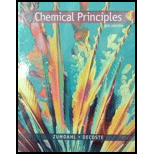
Concept explainers
Interpretation: The given table is to be completed.
Concept introduction: In a neutral atom, the number of electrons present are equal to protons. These two are also equivalent to the
The variation in number of neutrons causes variation in mass number. This results in isotopes of the elements.
Answer to Problem 44E
The complete table is shown below.
| Symbol | Number of Protons in Nucleus | Number of Neutrons in Nucleus | Number of Electrons | Net Charge |
Explanation of Solution
In the symbol of an
The given sumbol of the isotope in the first row is
The atomic number is equivalent to number of protons, thus, the atomic number is
The formula used for the calculation of number of netutrons is shown below.
Substitute the value of number of netrons and atomic number of ion in the above formula.
In the second row, number of protons and neutrons is
The atomic number is equivalent to number of protons, thus, the atomic number is
The formula used for the calculation of mass number is shown below.
Substitute the value of number of netrons and atomic number of ion in the above formula.
Therefore, the atomic symbol for isotope is
In the third row, number of protons, electrons and neutrons is
The atomic number is equivalent to number of protons, thus, the atomic number is
The formula used for the calculation of mass number is shown below.
Substitute the value of number of netrons and atomic number of ion in the above formula.
Therefore, the atomic symbol for isotope is
The given sumbol of the isotope in the fourth row is
The atomic number is equivalent to number of protons, thus, the atomic number is
The formula used for the calculation of number of netutrons is shown below.
Substitute the value of number of netrons and atomic number of ion in the above formula.
In the fifth row, number of protons, electrons and neutrons is
The atomic number is equivalent to number of protons, thus, the atomic number is
The formula used for the calculation of mass number is shown below.
Substitute the value of number of netrons and atomic number of ion in the above formula.
Therefore, the atomic symbol for isotope is
In the sixth row, number of protons and neutrons is
The atomic number is equivalent to number of protons, thus, the atomic number is
The formula used for the calculation of mass number is shown below.
Substitute the value of number of netrons and atomic number of ion in the above formula.
Therefore, the atomic symbol for isotope is
Thus, the complete table is shown below.
| Symbol | Number of Protons in Nucleus | Number of Neutrons in Nucleus | Number of Electrons | Net Charge |
Want to see more full solutions like this?
Chapter 2 Solutions
CHEM.PRINC.W/OWL2+REBATE+2 SUPPL.>IP<
- Balance the following equations by filling in the blanks. (a) 92235U+01n54137_+201n+_ (b) 90232Th+612__01n+96240Cm (c) 24He+4296Mo43100_+_ (d) _+12H84210_+01narrow_forwardThe atomic masses in die periodic table are relative masses and average masses. Explain.arrow_forwardAn element X bas five major isotopes, which are listed below along with their abundances. What is the element? Isotope Percent Natural Abundance Mass (u) 46x 8.00% 45.95232 47x 7.30% 46.951764 48x 73.80% 47.947947 49x 5.50% 48.947841 50x 5.40% 49.944792arrow_forward
- In Groups 4A-6A, there are several elements whose symbols begin with S. Name these elements, and for each one give its symbol, atomic number, group number, and period. Describe each as a metal, metalloid, or nonmetal.arrow_forwardPolystyrene can be prepared by heating styrene with tribromobenzoyl peroxide in the absence of air. A sample prepared by this method has the empirical formula Br3C6cH3(C8H8)n, where the value of n can vary from sample to sample. If one sample has 0.105% Br, what is the value of n?arrow_forwardEarly tables of atomic weights (masses) were generated by measuring the mass of a substance that reacts with 1.00 g of oxygen. Given the following data and taking the atomic mass of hydrogen as 1.00, generate a table of relative atomic masses for oxygen, sodium, and magnesium. Element Mass That Combines with 1.00g Oxygen Assumed Formula Hydrogen 0.126 g HO Sodium 2.875 g NaO Magnesium 1.500 g MgO How do your values compare with those in the periodic table? How do you account for any differences?arrow_forward
 Chemistry: Principles and ReactionsChemistryISBN:9781305079373Author:William L. Masterton, Cecile N. HurleyPublisher:Cengage Learning
Chemistry: Principles and ReactionsChemistryISBN:9781305079373Author:William L. Masterton, Cecile N. HurleyPublisher:Cengage Learning
 Chemistry: The Molecular ScienceChemistryISBN:9781285199047Author:John W. Moore, Conrad L. StanitskiPublisher:Cengage Learning
Chemistry: The Molecular ScienceChemistryISBN:9781285199047Author:John W. Moore, Conrad L. StanitskiPublisher:Cengage Learning Chemistry: Principles and PracticeChemistryISBN:9780534420123Author:Daniel L. Reger, Scott R. Goode, David W. Ball, Edward MercerPublisher:Cengage LearningChemistry: Matter and ChangeChemistryISBN:9780078746376Author:Dinah Zike, Laurel Dingrando, Nicholas Hainen, Cheryl WistromPublisher:Glencoe/McGraw-Hill School Pub Co
Chemistry: Principles and PracticeChemistryISBN:9780534420123Author:Daniel L. Reger, Scott R. Goode, David W. Ball, Edward MercerPublisher:Cengage LearningChemistry: Matter and ChangeChemistryISBN:9780078746376Author:Dinah Zike, Laurel Dingrando, Nicholas Hainen, Cheryl WistromPublisher:Glencoe/McGraw-Hill School Pub Co ChemistryChemistryISBN:9781305957404Author:Steven S. Zumdahl, Susan A. Zumdahl, Donald J. DeCostePublisher:Cengage Learning
ChemistryChemistryISBN:9781305957404Author:Steven S. Zumdahl, Susan A. Zumdahl, Donald J. DeCostePublisher:Cengage Learning





